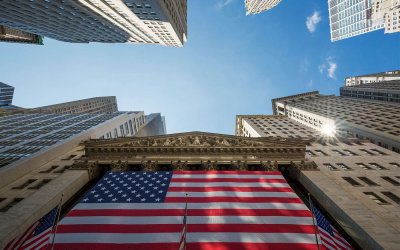A stock market bubble is when valuations in the equity markets reach unsustainable levels. Investor excitement and heightened enthusiasm can lead to unrealistic expectations pushing stock prices to lofty heights.
This somewhat reckless speculation isn’t typically backed by fundamentals like earnings. And eventually, the euphoria wears off, leading to rapidly declining stock prices akin to a crash. Some of the most well-known examples of stock market bubbles include the Dot Com bubble in 2000 and the housing market bubble in 2008.
Understanding what causes bubbles to form and how to protect an investment portfolio against them is a critical step on an investor’s journey.
What are the 4 types of market bubbles?
Market bubbles can come in different shapes and sizes. Each is ultimately driven by excess speculation. But depending on, which asset class is the target of this speculation defines the category of the bubble.
1. Stock Market Bubble
Stock market bubbles or equity bubbles involve shares in publically traded companies reaching exceptionally high valuations. Excitement about future growth leads to the market cap of popular fast-growing stocks rising significantly faster than underlying fundamentals. This can occur in a specific industry or in the market as a whole. And is precisely what led to the Dot Com bubble of internet stocks in the late 1990s.
A more recent example would be meme stocks in 2021, where retail investors deliberately forced the price of weak-but-loved businesses up. The group ultimately triggered a short squeeze that sent valuations flying. But at the end of the day, the underlying companies were still fundamentally compromised. And many meme stocks have since collapsed. Some have even filed for bankruptcy.
2. Asset Bubble
An asset bubble or financial bubble involves companies, sectors, and industries outside of the stock market. As such, overvaluation of asset classes such as bonds, currencies, and real estate are considered to be asset bubbles.
An example of a recent asset bubble would be the US housing market in the early 2000s. The rise of property values steadily accelerated for over half a decade, with mortgages being issued to families that didn’t even have any income. Eventually, the variable rates on loans kicked in, triggering a landslide of defaults across the entire country that led to a collapse of the US real estate market. The damage was so severe that it spread internationally, affecting almost every Western economy.
3. Credit Bubble
Credit Bubbles form when lending activity to consumers and businesses starts to get overly aggressive. This debt can come in many forms, including personal loans, business loans, student debt, and mortgages. Over-borrowing can result in a giant pile of obligations that may not be repayable, especially after interest costs are triggered.
Too much unsecured borrowing eventually leads to a spike in payment delinquencies and eventually defaults, causing the credit bubble to burst.
4. Commodity Bubble
Commodity bubbles can form relatively easily. When demand surges and supply remains constant or restricted, the price of a commodity can skyrocket relatively quickly. This can happen to any commodity, such as gold, oil, agricultural crops, metals, etc.
As businesses seek to capitalise on the elevated prices, the volume of supply eventually catches up, causing commodity prices to fall again. However, if demand starts to suffer, this newly built-up supply can cause commodity prices to plummet.
What are the 5 stages of a stock market bubble?
While the formation of a stock market bubble can stem from a variety of sources, each one follows the same five steps as defined by Hyman Minsky, an American economist.
1. Displacement
A new good or service grabs the attention of investors. These can come in virtually any form, including exciting new technology, a paradigm shift, or even a change in monetary policy like reduced interest rates. As expectations start to build up, the asset price starts to swell.
2. Boom
Word starts to spread, and investors falling prey to the fear of missing out (FOMO) start investing capital, building up significant momentum. The media start paying attention, getting more investors involved in what’s often described as a “once-in-a-lifetime opportunity”. This sends the asset price even higher.
3. Euphoria
At this stage, rational thinking has left the building. The momentum, paired with the excitement among investors, causes fundamentals to be ignored as people continue to buy, believing the price can only go up.
4. Profit-Taking
Shrewd investors keeping an eye on the balance between valuation and fundamentals start to realise that a bubble has formed. The “smart money” is moved out through selling, causing momentum to slow and valuation to level off.
In practice, pinpointing exactly when a stock market bubble will burst is nearly impossible. And English economist John Maynard Keynes is famous for saying, “the markets can stay irrational longer than you can stay solvent”.
5. Panic
With the momentum gone, investors begin to sell their stakes. This downward pressure causes other investors to follow suit. And soon, panic sets in, with almost every investor trying to sell the overinflated asset. The asset price collapses, the bubble bursts, and in extreme cases, it can even lead to a stock market crash.
Historical asset bubbles
History is filled with examples of asset bubbles, each caused by a different set of events. Let’s explore five of the most notable to see what exactly happened.
Tulip Mania 1637
Tulip Mania, also known as the Dutch Tulip Bulb market bubble, brought down the entire economy in Holland in the 1630s. The asset bubble started to form in 1634 by accident. The Flemish botanist Carolus Clusius brought tulip bulbs back from Constantinople (Istanbul) in the Middle East and planted them for scientific research.
However, the bulbs were stolen, propagated, and sold at premium prices. Due to their intense and varied colours, tulips became a status symbol among the wealthy class. And prices began to skyrocket, especially after one of the first futures exchanges was formed to facilitate even more speculation.
At the peak of the bubble, some of the rarest tulips were being sold for as much as $1m in today’s currency. And it reached the point where noblemen and laymen were trading whatever they owned to get their hands on one of these plants. That included their homes.
In 1637 the bubble burst. Tulips lost more than 99% of their value, and countless fortunes were destroyed in mere weeks. It continues to teach that when excessive greed and speculative spirit drive investing, the result is often a complete catastrophe.
The South Sea Bubble 1720
The South Sea Bubble is often dubbed the world’s first financial crash and the first Ponzi scheme. Even some of the most prominent men at the time, including famous physicist Issac Newton, saw almost £40m of his wealth wiped out in today’s money.
The bubble began to form in 1711 when an Act of Parliament created the South Sea Company. It served as a public and private partnership designed to consolidate, control, and reduce Britain’s national debt through trade with Spanish colonies in South America.
In 1713, the company was granted a trading monopoly in the region. And this included African slave trading to the Spanish and Portuguese Empires, which was immensely profitable at the time. Unfortunately, by the end of the War for the Spanish Succession, later in 1713, Spain began to tax slave imports and severely limit the number of ships Britain was allowed to send for trading. This created a significant problem since the South Sea Company had issued a 6% interest to anyone who bought its stock.
In 1718 King George took over the governance of the South Sea Company, further instilling investor confidence in a business that was yet to deliver on any of its trading promises. Two years later, the business was put in charge of Britain’s national debt. The idea was to use the South Sea Company’s equity to cover the cost of the country’s interest payments.
Over time, the valuation climbed higher and higher, and by August 1720 had reached a share price of £1,000. But one month later, the bubble burst. As trade with the Spanish colonies never materialised, the stock collapsed. And by December, it was worth only £124 – an 87.6% decline in three months. With the stock no longer carrying a high valuation to cover Britain’s national debt payments, a severe economic crisis followed.
Japan Real Estate Bubble 1991
In 1986 the Japanese economy fell into a recession following a surge in its currency value a few years prior. To counter the effects and stimulate the economy back into growth, the government ushered in a new monetary policy that later turned out to be too aggressive.
With excess cash flooding the financial markets, speculation on stocks and, more critically, land sent valuations through the roof. Between 1985 and 1989, the price of urban land exploded to unsustainable levels. One of the most extreme examples in Tokyo’s Ginza shopping district reached $250,000 per square metre. At the peak, Japan’s estimated total land value exceeded more than four times that of the entire United States – a country nearly 25 times larger.
In August 1990, over-speculation in the Japanese stock market came crashing down, with the Nikkei stock index being slashed in half. One year later, other asset classes, including real estate, began to tumble, with the bubble bursting in 1991.
Despite most asset prices collapsing by early 1992, Japan’s economy continued to decline for more than a decade after the event. And many investors now refer to this bear market period as “The Lost Decade”.
Dot Com Bubble 2000
The Dot Com bubble was a stock market bubble that kicked off in the late 1990s and eventually burst in 2002. It was created due to surging excitement surrounding the internet and other technology-based companies. With venture capital firms pouring capital into young businesses and pushing for an early IPO, tech stock valuations started to rise rapidly.
Between 1995 and 1999, the “cheap” money from retail investors created a gold rush for internet technology businesses. And speculation ran so rampant that a significant portion of companies going through an IPO didn’t even have a working product or service. As such, there were often no revenues or earnings backing up enormous valuations.
In 2000, the bubble burst. And between 2000 and 2002, a total of $5trn in market capitalisation across tech stocks was wiped out.
US Real Estate Bubble 2007
Arguably one of the most well-known stock market bubbles in recent history is the 2008 financial crisis. Many moving parts factored into what later became the complete collapse of the housing market within the United States.
With government policy pushing for home ownership in the late 1990s, demand for housing had been steadily rising. Once the Dot Com bubble burst, capital fled the stock market, and many investors started seeking a more stable asset class to invest in – real estate.
Property prices were pushed up further by the reduction of interest rates. Meanwhile, looser lending practices from mortgage brokers further lowered the barriers to entry, allowing speculation to start running rampant.
With adjustable-rate mortgages becoming the most popular and affordable, people started buying homes for the sole purpose of reselling them at a later date. While property prices climbed, this strategy proved incredibly lucrative. And between 1996 and 2006, US house prices had almost doubled, with 75% of this growth occurring after 2002.
But in 2007, after interest rates were increased, property values started to fall. And within a few short months, the bubble burst, with nationwide mortgage default rates skyrocketing.
The bottom line
History continues to teach us that excessive greed and “irrational exuberance”, as Alan Greenspan, former Federal Reserve Bank Chair, calls it, is the architect of stock market bubbles. Mass speculation continues to be prevalent in today’s markets, with excitement around cryptocurrencies and Special Purpose Acquisition Companies (SPACs) being some of the latest asset bubbles to burst.
Discover market-beating stock ideas today. Join our Premium investing service to get instant access to analyst opinions, in-depth research, our Moonshot Opportunities, and more. Learn More
This article contains general educational information only. It does not take into account the personal financial situation of the reader. Tax treatment is dependent on individual circumstances that may change in the future, and this article does not constitute any form of tax advice. Before committing to any investment decision, an investor must consider their individual financial circumstances and reach out to an independent financial advisor if necessary.





